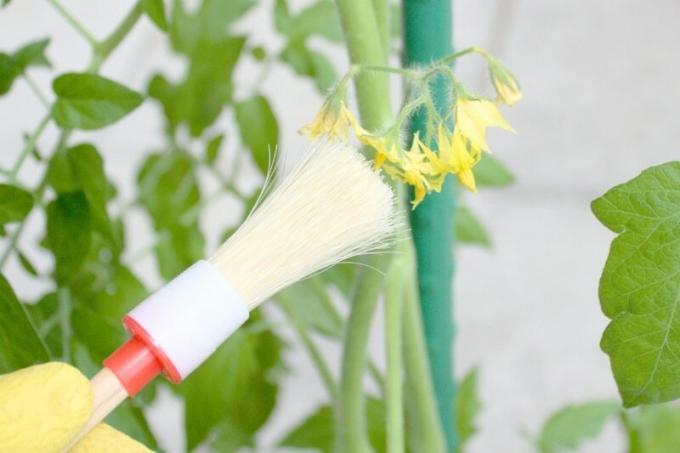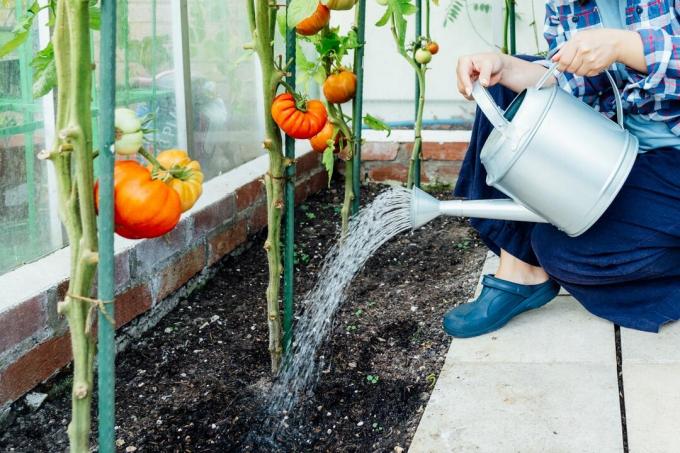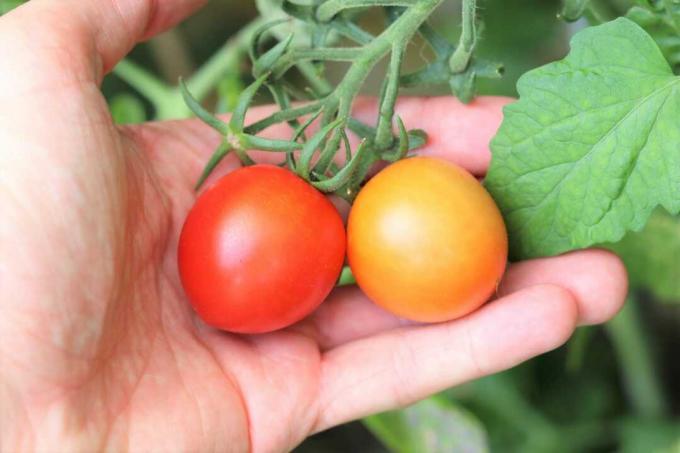
Tomatoes can be a real challenge for home gardeners when they just won't ripen. We look at how long tomatoes take to harvest and show some tricks on how to speed up the ripening process and improve the taste of the tomato.
In a nutshell
- Maturity can last up to 90 days after flowering
- early fruiting in cocktail tomatoes
- Fertilizing with potash after flowering promotes fruit formation
- reduced watering can accelerate ripening
- ripe fruit should be squeezable and easy to detach
Table of contents
- Average ripening time
- Maturity time by variety:
- accelerate maturation
- Identify ripe tomatoes
- frequently asked Questions
Average ripening time
Once the tomato flower is fertilized, the ripening process begins. Depending on the variety, this takes between 50 and 90 days. After around two to four weeks, the first fruit can be seen on a fertilized flower. The advantage of fertilizing the tomatoes is that different methods are possible. The wind mainly contributes to fertilization, but insects can also help.

Tip: For tomatoes in the greenhouse, where there is little air movement, you should shake the plants well or brush over the flowers at least once a day. This loosens the pollen and allows it to spread through the air.
Maturity time by variety:
If you want to harvest tomatoes throughout the summer, you should not only rely on an early variety. have early varieties pauses in flowering, which means that the ripe fruits can be missing in the main season of the tomatoes. With a mixture of at least three to four varieties with different ripening times, you can harvest for almost the entire season.
- end of June: Black Cherry, Golden Currant, Gold Nugget
- beginning of July: Bloody Butcher, Bright Fruit
- late July/early August: Prince Borghese
- late August/early September: Green Zebra, Pink Panderosa
- October: pineapple tomato, Winterkeeper

accelerate maturation
With the right care, ripening can be accelerated by an average of one to two weeks. You can also positively influence the taste of the fruit.
An important factor for maturity is the type of fertilization. Many hobby gardeners make the mistake of fertilizing with nutrients over the entire season. As soon as flowering begins, you should significantly reduce the nitrogen supply and use more potash fertilizers.
Advantages of potash fertilization:
- less strenuous height growth
- formation of more flowers and fruits
- The skin of the fruit becomes firmer
- Plants and fruits less susceptible to disease
You can also speed up maturation by reducing the watering. If the tomatoes hang taut for a long time but are green on the plants, first reduce the amount of water by half. Should still not appear after a week or two Set color change, halve the watering again.

Notice: When watering is reduced, make sure that there is no undersupply. Should the Plant with curled or permanently limp leaves respond, slightly increase the amount again.
Another method of bringing the ripening point forward is an earlier one sowing. On average, the tomatoes are harvested at the end of March or early April. If you have the right infrastructure with lighting and a room with a temperature of around 10 - 15 °C, you can start growing at the end of February or February. start in early March. As a result, the plants are significantly stronger and often have the first flowering buds when they are planted out in mid-May.

Notice: In the case of early rearing, a combination of nitrogen and potash fertilization is recommended when planting out in the first few weeks. This promotes shoot growth and flowering at the same time.
Identify ripe tomatoes
The variety of colors in ripe tomatoes is great. The spectrum ranges from creamy white to dark violet or dark brown shades. The color alone is therefore not a sure sign of recognizing a tomato with an optimal degree of ripeness. It is particularly difficult with varieties that ripen greenish. However, there are a few factors that can be used to identify a ripe tomato, regardless of color:
- Outer skin firm but easy to press
- Fruit comes off easily
- Fruit color fully developed

The optimal time window to harvest tomatoes is very limited. Overripe tomatoes can begin to spoil while still on the plant. They then have an unpleasant, slightly putrid to fermenting taste. Such tomatoes or tomatoes that have fallen off should be processed only with caution. Before you get into a dish, a small taste test should be made to see if it is still edible, so that you do not spoil the food.
frequently asked Questions
Yes, unripe tomatoes contain the toxic solanine, as found in all green parts of the tomato. Greenish ripening tomatoes, such as the "Green Gobiln" or "Green Zebra" varieties, which still have a light green-yellowish hue even when ripe.
Yes, you can let unripe tomatoes ripen. If unripe tomatoes have to be harvested in the fall due to the risk of frost, try to take lots of greens with you. If possible, harvest them together with the plant. The plant is then hung in a dark place until the tomatoes are fully ripe. However, the taste of ripened tomatoes is much weaker and they are often only suitable for cooking.
If you have tomatoes in pots or tubs, you can bring the plants inside before they get the first frost. The time in the house is usually sufficient for unripe fruit to ripen. However, in order to keep the tomatoes indoors throughout the winter, you need a suitable infrastructure where the plant gets at least nine hours of light.
